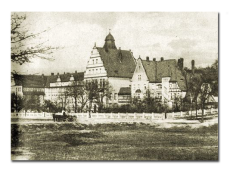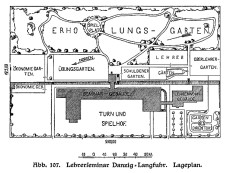History of the former building of the Faculty of Chemistry
History of the former Chemistry Department building
Royal Teachers' Seminary, former building of the UG Department of Chemistry
For the Catholic teachers' seminary in Gdansk-Wrzeszcz, which rented insufficient rooms for its needs, since its foundation in 1902, new buildings were erected in 1905-1908. According to the executive plan, the construction project included:
- A seminar building with seminar classrooms and classrooms for school exercises, living quarters for 60 and working quarters for 90 seminarians, as well as (in a separate wing) rooms for business activities
- Residential building for teachers
- Outbuilding (pigsty)
- Toilets
- Accessory facilities, playgrounds and sports field, courtyard, gardens, etc.
Since a suitable building site of the size required for such an institution could not be acquired in the center of the suburb of Wrzeszcz, the seminary was therefore built outside the built-up part of the city, in the scenically charming Royal Valley in the south of Wrzeszcz. The rectangular parcel of land, 200 meters long and 125 meters wide, located with its longer side by the Royal Valley Route, was initially unsuitable for construction, as it rose an average of 17 meters from the street in depth. It therefore had to be leveled along the course of the street 50 meters in depth, with the acquired land masses being used immediately to raise the street level as necessary. The nature of the site thus acquired had a decisive impact on the construction project. In order to obtain, on the one hand, a playground and pitch that was useful in terms of size, and, on the other hand, to avoid the direct location of the buildings on the street, the buildings were located 3 m from the slope of the hill, so that only the space needed for a detour was left on the side of the rear wall of the house, and at the same time for the easy drainage of rainwater flowing down the hill. In this way, there was still enough land left in front of the buildings for a playground and playground, as well as individual gardens, while on the sloping ground behind the buildings, seminar, utility and teacher's gardens could be established. The layout of the buildings on the plot, as well as the layouts of the courtyard, squares and gardens can be seen on the site plan.
With the exception of the separately standing outbuilding, all the buildings form one picturesque structure. The seminary building includes:
- classrooms: an exercise school with four classrooms for 40-50 children and 10 seminarians each and one classroom for 50-60 children and 30 seminarians, further three lecture halls for seminarians, the largest of which is calculated for 60-64 alumni, an auditorium, a music room, eight musical exercise rooms, one drawing room with a modeling room, a physics office with a preparation room and for teaching aids, as well as a gym with a lockerroom and room for instruments and a teacher's room.
- for general purposes: a library room, a conference room and a teachers' room, rooms for teaching aids and collections, a work room for 30 extranal seminarians, as well as two reserve rooms.
- seminarians' quarters: a living and work room for 60 seminarians, three bedrooms with 20 beds each, two washrooms with toilets, closet and cleaning rooms, two sick rooms with an adjoining nurse's room, bathroom and toilet, further a bathhouse with eight showers and three bathtubs, and a storage cell for beds, linen, suitcases, etc.
- utility rooms: an apartment for the bursar with rooms for the maintenance staff, a kitchen with pantries, a canteen with a preparation room and an anteroom that is also a washroom, a laundry room with a room for mangling and ironing, a necessary basement and attic room, a boiler room for low-pressure steam central heating with rooms for coal, an elevator for groceries and an elevator for linen.
- an apartment for the janitor. In addition, the building temporarily houses Preparando Wrzeszcz (a preparatory school for the teaching profession).
In the teachers' apartment building, which is connected to the main building by a passageway (connector), there are: - on the first floor two teachers' apartments, each with four rooms and equipment, - on the second floor the principal's apartment with four rooms and equipment and an office located next to the connecting passage, and on the second floor the professor's apartment with five rooms and equipment.
The toilet building is located on a detour behind the center of the seminary building and is connected to it on the first floor by an entrance gate, and on the second floor by a connector located above the gate. This building contains toilets for the exercise school on the first floor and for seminarians on the second floor, and has a passageway to the garden. In addition, there are toilets for teachers on both levels.
The layout of the plan of the seminary building can be seen in detail in the drawing. It should be noted in particular the easy possibility of later enlargement of the establishment by adding a wing of the building to the rear wall, the orientation of the classrooms generally toward the west, the physical study to the south and the drawing class to the north; the advantageous location of the exercise school on the first floor with a separate entrance and exit; the separate location of the sick ward, as well as the peculiar adoption of a bay window (balcony) for an altar niche on one of the narrower walls of the auditorium.
Regarding the method of construction, the following should be mentioned: the ceilings of the seminary building are massively constructed everywhere, namely over most of the basement as Prussian ceilings, in the classroom corridors of the first floor and second floor as cradle vaulting, in the gymnasium wing and in the halls next to the main staircase as so-called Koenenen vault ceilings, and in the rest, with the exception of the ceilings on the top floor, according to the Klein system using brick blocks. The top floor generally received ceilings made of rammed concrete with iron inserts. A brick ceiling was abandoned here because, with the intense heat transmission towards the cold attic, due to differences in the heat permeability of bricks and mortar, it was feared that dust would settle unevenly on the ceiling and thus make the joints visible. The teachers' residential building received wooden ceilings in the living quarters, above the basement and in adjacent rooms; solid ceilings.
The floors consist of: in the gym, auditorium and janitor's apartment; located in the basement of stave flooring in asphalt, in the corridors, utility rooms, baths and toilets of red fleece (ceramic tile) and terrazzo, in the lower basement of cement coating and brick flooring and in the rest of the basement of cement coating covered with linoleum.
The attic received floors of gypsum coating. The apartment building has plank floors (in the living quarters) and terrazzo floors in adjacent rooms. The stairs, except for the granite steps in front of the entrances to the buildings and the wooden stairs of the teachers' apartment building, are made of artificial stone with linoleum lining.
Space heating in the seminary building is low-pressure central steam heating, and there are tiled stoves in the teachers' residence . The supply of fresh air is through windows, which for this purpose have been equipped in classrooms with tilt window sashes, and in the corridors - with glass louvers, while the removal of used air is carried out through ventilation ducts. The lighting of the edifice is gas-fired.
The design of the gym wing is peculiar. Since the longer walls of this wing, with a length of 20 meters and a height of almost 17 meters, are not sufficiently braced by the transverse walls, (in order to avoid the considerable and therefore costly wall reinforcements required by the static calculations), at the height of the dangerous section, an iron wind brace ("wind bracing") was established in the floor of the second floor, so that the wind pressure is transferred to the sufficiently strong gable walls. Above the second floor of this wing, four iron roof trusses of trapezoidal shape were erected, the upper edges of which hold the ceiling of the second floor and the roof above it.
The roofs are constructed of wood and tiled monk and dandelion, clock tower with carpeting tile.
The equipment of the rooms is simple, in accordance with the purpose of the building; only the hall is equipped with wooden panels and wooden coffered ceiling and painted windows.
The exterior fronts are in the style of the German Renaissance. The architectural elements are made of yellow Silesian sandstone and the planes are made of plaster, lime mortar, with preserved natural tones.
Construction costs were, according to estimates, respectively:
the main building - 409 000 marks
residential building for teachers - 76 900 marks
outbuilding building - 1 000 marks
additional devices - 23 000 marks
and the interior equipment purchased to complement the existing equipment, including the organs in the hall: 33 400 marks.
Construction began in the spring of 1905, and the building was handed over on April 1, 1908.
The construction was carried out according to a design that was drafted by the ministerial clerk of Uber’s secret construction advisor on the basis of a preliminary design developed by the Royal District Building Inspector Muttray. During the construction, the project underwent several changes, especially regarding external architecture. The chief construction manager was Ehrhardt, the government and construction adviser, and supervision was exercised by Muttray, the secret construction adviser. Construction management was in the hands of the government’s Minister of Construction Raasch.
Translated from German: "Danzig und seine Bauten" (1908), dr Rita Walczyna
The site comes courtesy of dr Tomasza Plucińskiego






